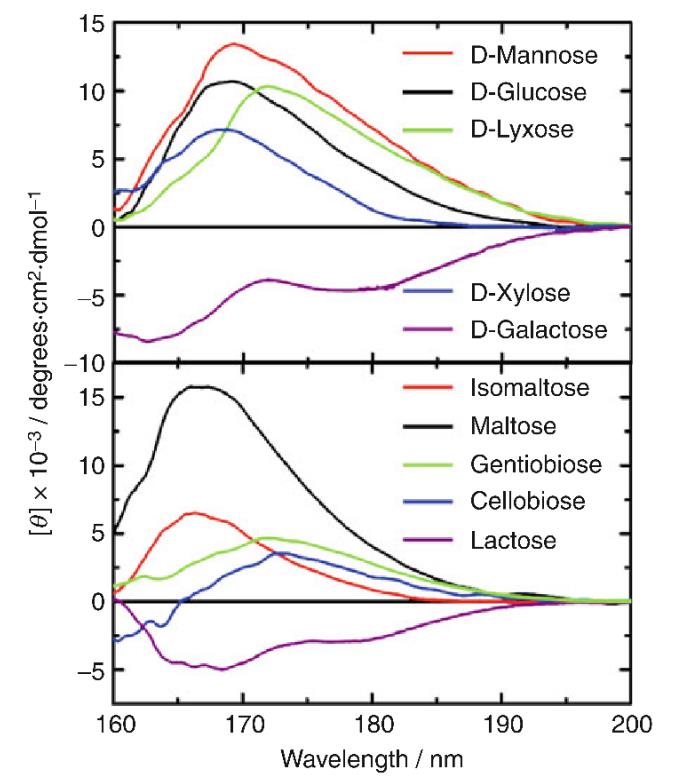Application of Circular Dichroism Spectroscopy in Carbohydrate Research
Circular dichroism (CD) spectroscopy has emerged as a powerful technique for probing the structural intricacies of biomolecules. In the realm of carbohydrate research, CD spectroscopy holds immense significance. Utilizing CD spectroscopy in carbohydrate research, Creative Biostructure provides an exceptional vantage point for exploring their conformations, interactions, and stability.
Circular Dichroism Spectroscopy in Carbohydrate Research
Circular dichroism is a common routine method for analyzing the structure of carbohydrate compounds. Polysaccharides are chain polymers formed by the dehydration of aldose or ketose to form glycosidic bonds connected linearly or branched by glycosidic bonds. Its advanced structure (two, three, four levels) is a regular conformation formed between the polysaccharide main chains through non-covalent bonds. The variety and complexity of polysaccharide circular dichroism spectra are determined by the types, spatial orientations, glycosidic linkages, and polysaccharide spatial conformation of chromophores in polysaccharides. From the shape and strength of the sugar compound circular dichroism, the structural information of the primary structure and spatial conformation of the oligosaccharide (or polysaccharide) can be obtained, so it can be used as a detection method for the structural change of the sugar compound.
There are two types of circular dichroism assays for polysaccharides: One is the circular dichroism spectrum below 200nm wavelength, which is recorded by a vacuum Circular dichroism instrument. It is called the vacuum circular dichroism spectrum. A specific solvent needs to be selected to reduce the influence of the solvent on light absorption. This area reflects the linking mode and spatial conformation of polysaccharides. The second is the circular dichroism spectrum with a wavelength above 200nm, called the induced circular dichroism spectrum, which is suitable for determining sugars containing π-electron functional groups, or after the derivatization of polysaccharides.
 Figure 1. VUVCD spectra of monosaccharides (top) and disaccharides (bottom) in aqueous solution at 25°C. (Gekko, K, 2018)
Figure 1. VUVCD spectra of monosaccharides (top) and disaccharides (bottom) in aqueous solution at 25°C. (Gekko, K, 2018)
How to Study Carbohydrate Using CD Spectroscopy
The process begins with sample preparation, where we ensure the integrity and purity of the carbohydrate molecules. Subsequently, the samples are subjected to CD spectroscopy, and the resulting spectra are meticulously analyzed by our team of skilled experts. Our approach involves comparing experimental spectra with reference data and employing advanced computational tools to deduce the secondary structures and conformational changes of the carbohydrates. This enables us to decipher the structural transitions that underlie their functional roles, shedding light on the intricate interplay between structure and activity.
What Can We Offer?
With rich circular dichroism spectroscopy service experience and excellent scientists, Creative Biostructure provides customers with the following CD spectroscopy applications in carbohydrate research:
- Structural Analysis of Carbohydrate Compounds
The conformation of carbohydrate compounds is usually characterized by its multidimensional potential energy surfaces. The theoretical models of these potential energy surfaces are also the main field of conformational research at present, and the results provide a useful structural framework for the conformation (helix or disordered coil) of carbohydrates. The purpose of circular dichroism's research on carbohydrate conformation is to distinguish between coiled and helical, rigid and flexible structures, and determine the distribution of link conformation groups.
- Observation of the Photonics of the Electronic Transitions
Carbohydrates contain hydroxyl and acetal groups with high-energy electronic transitions below 190 nm, the short wavelength limit of conventional circular dichroism spectrophotometers in aqueous solutions. With improved optical devices and cells and the use of synchrotron radiation (SR) as an intense light source, circular dichroism measurements have been extended to the VUV region below 190 nm, allowing direct observation of the photonics of the electronic transitions of carbohydrate molecules.
- Microconformation Analysis
Carbohydrates, with their diverse stereochemical arrangements and functional roles, present intricate conformational landscapes that profoundly influence their bioactivity. Our specialized CD spectroscopy service offers a sophisticated platform for the meticulous analysis of carbohydrate compound microconformation.
Advantages of Our Service
- Cutting-Edge Expertise: Our team comprises accomplished scientists with extensive experience in structural biology and biophysics. Their proficiency in CD spectroscopy ensures the accurate interpretation of complex carbohydrate spectra.
- Customized Approach: We recognize the uniqueness of each research project. Our service is tailored to your specific needs, ensuring that you receive the most relevant and insightful results.
- Comprehensive Insights: Our analysis extends beyond raw data interpretation. We provide in-depth insights into the implications of structural findings, aiding you in making informed decisions for your research or project.
- Timely Deliverables: We understand the value of time in scientific exploration. Our efficient workflow and dedicated team ensure that you receive timely and accurate results without compromising quality.
Drawing from extensive experience in CD spectroscopy, Creative Biostructure delivers enhanced reliability in elucidating spatial structures of carbohydrates for our valued customers. We promise to work closely with our customers to provide excellent services. Please feel free to contact us for a detailed quote if you're interested in our services.
Ordering Process
Reference
- Gekko, K. Carbohydrate Circular Dichroism. Encyclopedia of Biophysics. Springer, Berlin, Heidelberg. 2018, 214-216.
